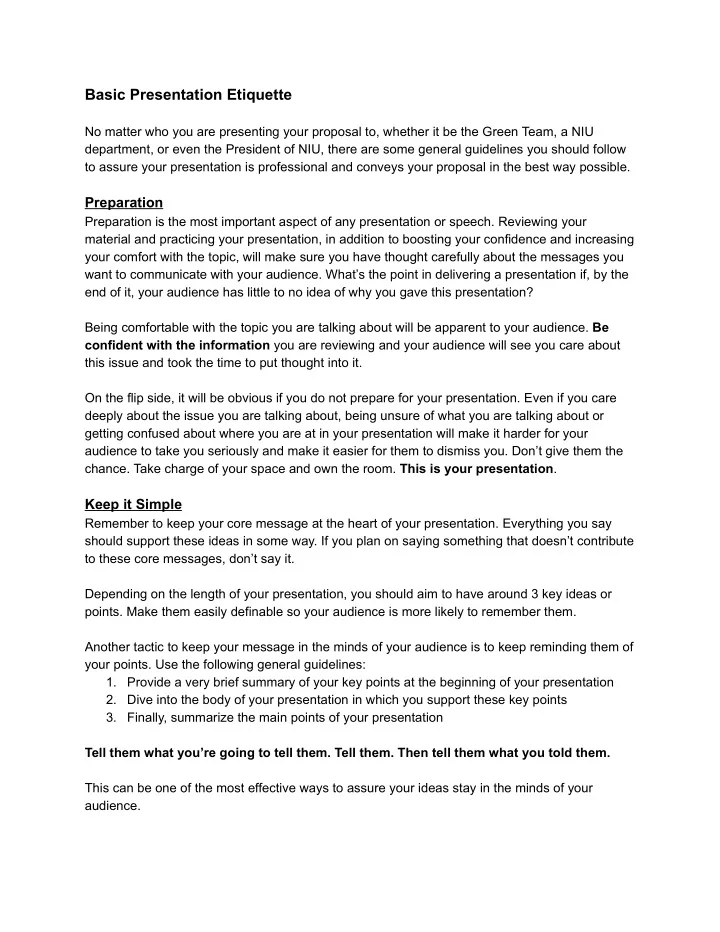

Basic Presentation Etiquette No matter who you are presenting your proposal to, whether it be the Green Team, a NIU department, or even the President of NIU, there are some general guidelines you should follow to assure your presentation is professional and conveys your proposal in the best way possible. Preparation Preparation is the most important aspect of any presentation or speech. Reviewing your material and practicing your presentation, in addition to boosting your confidence and increasing your comfort with the topic, will make sure you have thought carefully about the messages you want to communicate with your audience. What’s the point in delivering a presentation if, by the end of it, your audience has little to no idea of why you gave this presentation? Being comfortable with the topic you are talking about will be apparent to your audience. Be confident with the information you are reviewing and your audience will see you care about this issue and took the time to put thought into it. On the flip side, it will be obvious if you do not prepare for your presentation. Even if you care deeply about the issue you are talking about, being unsure of what you are talking about or getting confused about where you are at in your presentation will make it harder for your audience to take you seriously and make it easier for them to dismiss you. Don’t give them the chance. Take charge of your space and own the room. This is your presentation . Keep it Simple Remember to keep your core message at the heart of your presentation. Everything you say should support these ideas in some way. If you plan on saying something that doesn’t contribute to these core messages, don’t say it. Depending on the length of your presentation, you should aim to have around 3 key ideas or points. Make them easily definable so your audience is more likely to remember them. Another tactic to keep your message in the minds of your audience is to keep reminding them of your points. Use the following general guidelines: 1. Provide a very brief summary of your key points at the beginning of your presentation 2. Dive into the body of your presentation in which you support these key points 3. Finally, summarize the main points of your presentation Tell them what you’re going to tell them. Tell them. Then tell them what you told them. This can be one of the most effective ways to assure your ideas stay in the minds of your audience.
Connect with Your Audience You are giving this presentation because you care enough about something to try and do something about it. Let that drive and passion shine through. Your audience will feel it and be more connected with what you are saying. Being enthusiastic and honest will get you far. Language Use common/nontechnical language when talking to your audience. If you absolutely need to use a technical term or phrase, be sure to define it so there is no confusion among your audience members. DO NOT swear or use crude language. It is one of the fastest ways to alienate your audience and lose their respect. Also, using swear words is just downright lazy writing. You have a vocabulary in your head, use it! Body Language Your body can be just as effective at conveying a message as your voice is. Smile and make eye contact with your audience. Eye contact can help in 2 ways: 1) It builds rapport with your audience which helps them connect to you and your subject. 2) It can also help with your confidence since you are talking to individual audience members instead of a large mass of strangers. Closed off body language such as crossing your arms, not moving that much, and putting your hands either behind your back or in your pockets can give the impression you are nervous and are unsure of your presentation. Instead, keep your body open and use gestures to help emphasize your points. Depending on the format and setting (and if you have the space) move naturally around your stage and among the audience if possible. It will increase the connection between you and your audience and continue to build your rapport with them. Do this sparingly, however, as sometimes too much movement can be a distraction and can, at times, be awkward and draw attention away from your presentation. When Presenting to the Green Team Chances are that a good number of you, if you are serious about your project, are going to be presenting to the green team at some point. The green team is a collection of faculty, staff, community members, and select students who are serious about advancing the sustainability of NIU and of Dekalb, which means they are on your side. Every member is passionate about the environment and cares about humanity's impact on the world
This means that you can expect a high level of attention and respect for you when you give your presentation. You can also expect to hear feedback from the team about your proposal: strengths, weaknesses, what to improve upon, where to go now, etc. Due to the limited number of times that the green team meets over the course of the year, the first Wednesday of every other month, time for you to give your presentation will be limited. You will be asked to make your presentation roughly 5 to 10 minutes in length. These are only basic tips on giving a presentation, for more information about giving effective presentations, these following sites are good starting points: ● https://www.skillsyouneed.com/present/presentationtips.html ● https://www.skillsyouneed.com/present/preparepresentation.html ● https://www.usnews.com/education/blogs/professorsguide/2010/02/24/15strategiesfor givingoralpresentations
Recommend
More recommend